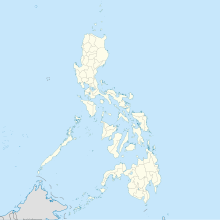Francisco Reyes Airport
|
Francisco B. Reyes Airport Paliparang Francisco B. Reyes (Filipino) Hulugpaan sang Francisco B. Reyes (Hiligaynon) |
|||||||||||
|---|---|---|---|---|---|---|---|---|---|---|---|
 |
|||||||||||
| Summary | |||||||||||
| Airport type | Public | ||||||||||
| Operator | Civil Aviation Authority of the Philippines | ||||||||||
| Serves | Coron and Busuanga, Palawan | ||||||||||
| Location | Decalachao, Coron, Palawan | ||||||||||
| Elevation AMSL | 45 m / 148 ft | ||||||||||
| Coordinates | 12°07′17″N 120°06′00″E / 12.12139°N 120.10000°ECoordinates: 12°07′17″N 120°06′00″E / 12.12139°N 120.10000°E | ||||||||||
| Website | franciscoreyesairport |
||||||||||
| Map | |||||||||||
| Location in the Philippines | |||||||||||
| Runways | |||||||||||
|
|||||||||||
| Statistics (2008) | |||||||||||
|
|||||||||||
|
Statistics from the Civil Aviation Authority of the Philippines.
|
|||||||||||
| Passengers | 51,431 |
|---|---|
| Aircraft movements | 3,376 |
| Metric tonnes of cargo | 1,235 |
Francisco B. Reyes Airport (Filipino: Paliparang Francisco B. Reyes; Hiligaynon: Hulugpaan sang Francisco B. Reyes), formerly Busuanga Airport (IATA: USU, ICAO: RPVV), is an airport serving the general area of Coron, located on Busuanga Island in the province of Palawan, the Philippines. It is also shared with the neighboring municipality of Busuanga, located on the western half of the island. Since November 10, 2008, the airport has been named after Francisco B. Reyes, the mayor of Coron from 1936 to 1939 who donated the land that forms the current airport complex.
The airport is classified as a Class 2 principal (minor domestic) airport by the Civil Aviation Authority of the Philippines, a body of the Department of Transportation and Communications that is responsible for the operations all airports in the Philippines except the major international airports.
The airport is surrounded by a protected ranch used to raise cows. The grass growing on the property is imported from Australia.
Francisco B. Reyes Airport is the target of two expansion projects. The first expansion, funded in part by a $3 million loan from the Korea International Cooperation Agency (KOICA) in cooperation with the Department of Transportation and Communications, broke ground in March 2007. The expansion, which included the construction of a new terminal building, the completion of the airport's then-unfinished concrete runway and the upgrading of other facilities, was inaugurated by President Gloria Macapagal-Arroyo on November 17, 2008.
...
Wikipedia

